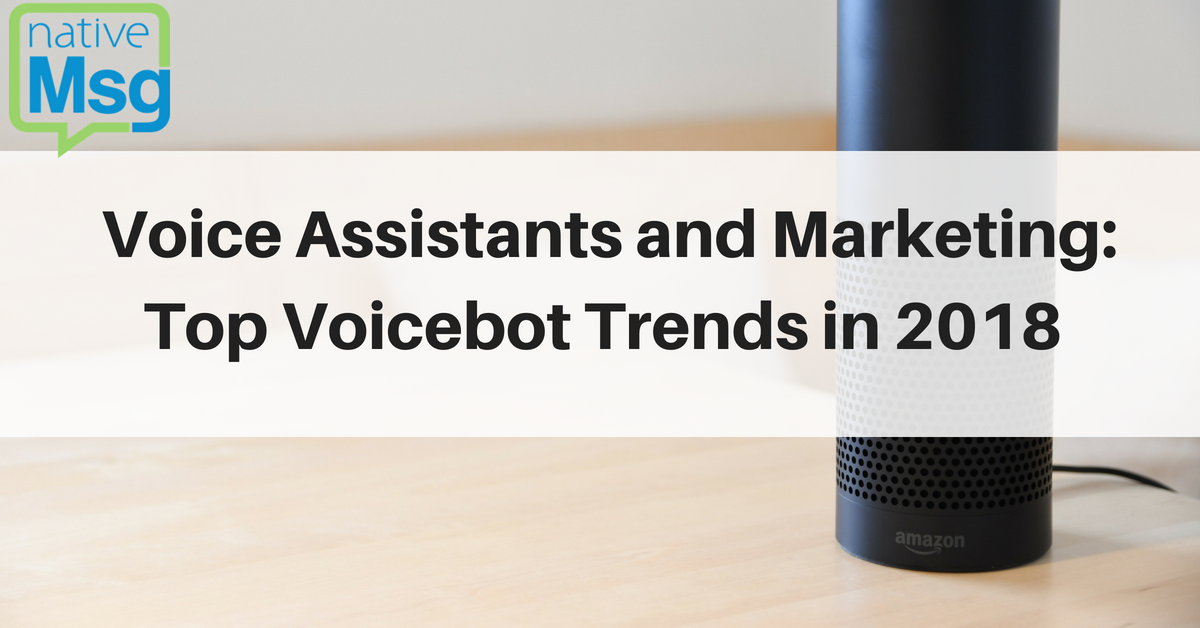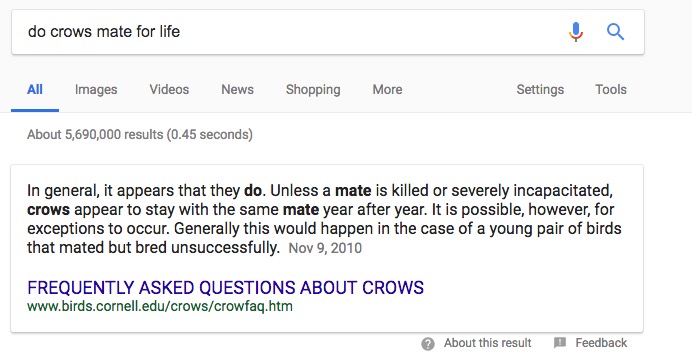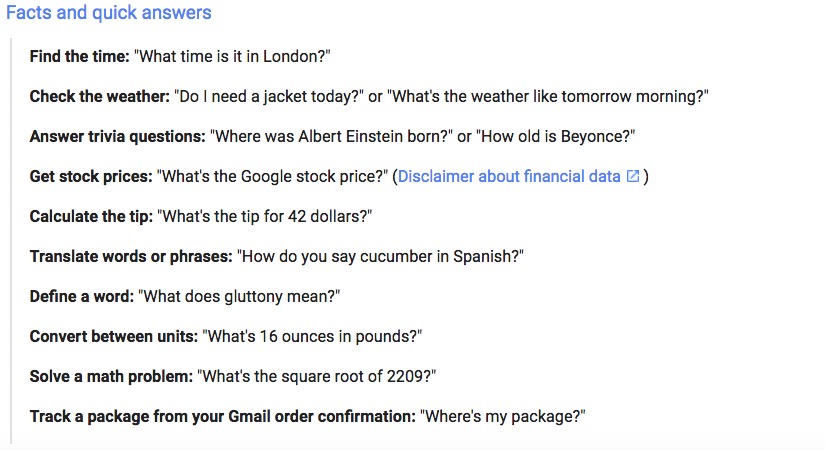
If you were offered a way to fast-track your brand toward becoming a leading authority in your industry, landing Google snippets for all key search intents, trendsetting new UX and increasing customer retention, you’d consider it, of course!
Right now is an auspicious time for businesses to dive into marketing for voice assistants. Here’s the top trends in 2018. Include just one of these trends in your strategy now, and you’ll better position your brand to be a leading “voice” in your industry (pun intended).
Voice Assistants and Marketing Trends in 2018
The leading, and most basic opportunity, for any business to harness is within the context of search. More and more, consumers are relying on voice commands on device. There is a layered ecosystem forming around voice. It also includes text, SEO, content channels and device applications (or the internet of things IoT).
When a modality increases in popularity, Google and other search engines begin to factor these into search decisions. That happened with mobile, and is now occurring with voice assistants.
Where does voice assistant search fit in? One of the most informative and commonly published stats is that in the next two years, voice search will account for 50 percent of search, per comScore.
That’s an ambitious figure given the current state of voice. Apart from home commerce and major brand initiative, it isn’t dominating like sites or text just yet. But it certainly drives the point of how essential intelligent voice assistants are becoming, no matter the industry.
Voice Search Fast-tracks Businesses in Results
As a marketer, you’re always seeking to find the best way to optimize your content for leading results. Here’s the basic equation for great search results and landing that coveted snippet spot: Create a long-tail, actionable and explicit query with the clearest and simplest answer, and the better your chances of getting that sweet Google snippet spot.
Equation: long-tail query + plain, explicit answer = Snippet Best Practices
What’s more, voice search embodies these components better than text does. Users almost always begin a query as a question that naturally includes a long-tail (or longer queries with a higher density of words synonymous with or surrounding a keyword). These user questions are overwhelmingly actionable, and the results are typically simply explained, making voice queries a logical resource for Google to draw upon in rich snippet features.
If you just stopped at considering voice search only within the context of home-use, you probably might come to the same conclusion that Search Engine Land relayed; on the whole, voice search for home naturally includes simple step commands around activation.
But, consider this somewhat obscure search query, “Do crows mate for life?” (or maybe this is not so obscure if you also enjoy a cacophony of crows first thing in the morning). You see that the snippet answers the exact question and includes additional information that rounds out the question. While birdwatching or owning an aviary business may not be your thing, the results show how voice search and long-tail keywords (“crows mate,” “crow’s life”) can help to secure that snippet and result.

Voice Assistants Shifting Traditional SEO (for the Benefit of Your Business)
These examples haven’t included conversational commerce, and that’s how marketers can get a jump on higher results.
Voicebots (or voice assistants) are chatbots for voice. Chatbots can be designed as both text and voice-based. While we agree, it’s pretty cool to be able to use Cortana on Windows 10 across any device, voicebots designed for business are actually more flexible than Cortana, Siri and even OK-Google because they can be deployed across channels and devices. You don’t have to be on Google, Windows 10 or a smart speaker only. With a chatbot (or voicebot) application, you can be onsite, on social, on device, on appliance or in other messaging channels.
- A voicebot can be made with Alexa skills and deployed on any device, which conversational AI developers can design for your business.
- Voicebots can also be developed with a conversational AI platform and be deployed on any social channel your consumers most engage on.
The best part is that intelligent voicebots are designed conversationally, using natural language. They provide a wealth of features, including web hooks for website results within the message, so consumers can go straight to a site within the messaging channel.
To see where to start with voice-based queries, OK-Google requests are an example of the kinds of complex queries, across subjects, that can work.


Some of the queries are simple and won’t compel a user to click through in results. But these are starting points in engaging users to learn more. Adding examples can help you do that. For instance, not only might you answer what gluttony means, but you can provide compelling context to it, such as a human interest example of the self-described “most gluttonous man,” to increase a click through opportunity.
If you’re building a voicebot or chatbot, flows that are natural conversationally, but that also combine a human element (just who was the “most gluttonous man?” you say) and calls to action will help you stay ahead of the curve in SEO.
Voice Assistants are Supplanting Sites
Voice assistants aren’t fully crowding out traditional sites––yet. There aren’t that many players in the space for that to happen right now. Though, consider that big tech and big brands engender the majority of interaction with voice assistants where 41 percent of adults say they use voice search daily and you can see the where the path is heading. What’s more, that statistic is from 2014 Google’s Mobile Voice Study and voice search is even more common today.
Currently, stats point to how voice assistants may be inching us closer to an overlap between the digital and physical realm. Google Home use is on the uptick and the next generation entering the purchasing power space, Generation Z, are teenagers now who use voice search almost interchangeably to texting.
Voice Assistants are Popular for Local Business Search
Data shows that voice assistants are preferred for food and grocery orders, hotel booking, retail clothing shopping and even for doctor support. Consumers enjoy the ease of voice orders and scheduling in these spaces.
- Smartphones account for the highest levels of voice search. A 2018 study shows that 56 percent of consumers go to their mobile phone, first, with only 18 percent using a smart device.
- Almost a third of consumers use their desktop for local business voice search, reports the study, compared to 18 percent on smart devices.
What Should Marketers Do to Stay Competitive?
Become hyper-savvy with user-intent and context-driven content
Currently, simple signals can help determine intent. Dividing queries into the common “Want to” formats of Go, Know, Buy and Do, or the typical queries users have on voice, are a foundational step for content creation.
They also serve to inform how you answer these, whether within a voice or text-based format. It’s also imporant to create content that provides effective answers to these queries as high-level content.
For example, say a user inquires about the types of swimming pools available. First, this query shows where a user is within the sales funnel. Here, they’re obviously in the awareness stage, and want to learn more about the kinds of products available.
Second, marketers need to deliver intent-based content that provides a simple list. Intent-based content means you include both material and design in your answer to drive awareness and then garner further clarity about what’s most important to a consumer.
Keep in mind, this strategy helps optimize your content for better results in search anyway. But you can also use this approach when designing a voice assistant or for any voice assistant that your consumers most engage on.
Embrace conversational copy as the standard
Again, more than ever, conversational copy is important. Readers have welcomed the tone and pacing because it’s easier to read. But with voice search, Google’s Rank Brain factors in longer-tail phrases and natural language for both result-ranking and intent. It’s a good time to steer content toward long-tail keyword search both organically and through paid search.
Make sure users understand they’re talking to a machine
Take note of what may be “the Duplex Effect.” We stand to see where and how Google’s recently introduced “Google Duplex,” which can call a business directly to book reservations or ask questions, will land in the sphere of public opinion. Through Google Assistant, Google Duplex allows users to simply make those appointments, using conversational AI that skews close to the uncanny valley in human-likeness. With uptalk, inflections and other human conversational components, it’s hard to tell this isn’t a human.
For now, the vast majority of consumers prefer to know when they’re talking to a computer. It’s best to err on the side of transparency as this aligns with the ethics and moral value consumers place on human to robot interactions.
There is another angle to look at, however, where voice assistants are concerned, and that’s how people learn best. The fact is, most people are visual learners. You’ll want to keep in mind that when it comes to effective communication and sales, 65 percent of the population learns by seeing, whereas only 30 percent learn by hearing. The upside is that with web and voice search, you can use both modalities to engage visual or auditory learner. Likewise, designing a text or voice based chatbot that’s interactive? Well, that’s a bonus for every type of learner and also includes the five percent who are kinesthetic learners.
Learn more about how to build a voice assistant or chatbot for your business with nativeMsg.
Free Trial
Get Started With RCS
Business Messaging!
Unlock the power of RCS and revolutionize your customer engagement.



